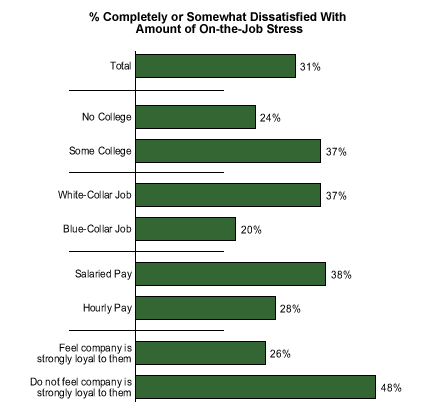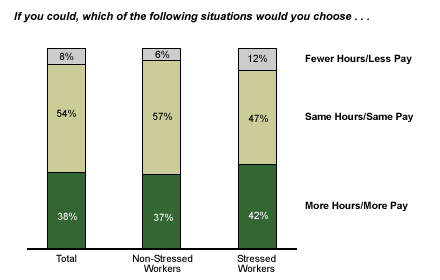Corporate downsizing during last year's recession has many American employees facing heavier workloads at the office. In addition to the extra hours, many must cope with the threat of additional layoffs. And the stumbling economic recovery indicates that these concerns aren't going away soon.
According to an August 2002 Gallup Poll*, 31% of U.S. workers are somewhat or completely dissatisfied with the amount of stress they face at work. Workplace stress can cause increased health problems, higher rates of worker absenteeism and turnover, and anxiety at home. Its effects are felt beyond the workers themselves -- companies may experience higher health insurance premiums and lower productivity, and family members may suffer the effects of cranky workers getting home late in the evening after pressure-filled days at work.

A Price to Pay for Success
Survey data for stressed workers (people who are somewhat or completely dissatisfied with the amount of stress in their jobs) versus non-stressed workers (those who are completely or somewhat satisfied with the amount of on-the-job stress they face) reveal significant differences between average levels of educational attainment, white-collar versus blue-collar positions, and salaried versus hourly jobs. It appears that increased stress is a price to pay for traditional workplace success.
While it may seem that furthering one's education should create opportunities for less stressful jobs, the opposite appears to be the case. Thirty-seven percent of people with at least some college education say they are stressed on the job, compared to 24% of people with a high school education or less.
White-collar jobs, in general, carry higher levels of stress than blue-collar jobs -- 37% of white-collar workers say they're dissatisfied with the amount of stress in their jobs and 21% of blue-collar workers say the same.
Salaried workers generally earn more than hourly workers, and they also are more likely to say they feel pressure on the job. Thirty-eight percent of salaried workers are stressed, versus 28% of hourly workers. It may be that hourly jobs carry less responsibility, but it also may be that salaried workers (who are often ineligible for overtime) tend to view increased workloads as burdensome, while hourly workers may see more work as an opportunity to reap additional overtime pay.
Loyal Companies Associated With Lower Worker Stress Levels
Only 26% of workers who feel that their companies have a strong sense of loyalty to them are stressed, while 48% of workers who say their employers lack a strong sense of loyalty to them are dissatisfied with their workplace stress levels. This dichotomy may have to do with job security concerns, or it may simply be that a lack of perceived employer loyalty makes for a more stressful work environment overall. Regardless, these results suggest that companies might be able to lower worker stress levels by working to show that they trust and will stand behind to their employees.
Choosing Money Over Stress
If given the choice, would stressed workers prefer to spend fewer hours on the job for less pay? In fact, a mere 8% of workers would choose that option, while 38% are willing to work more hours for more pay. More than half (54%) would choose to keep their hours/pay distribution unchanged. Stressed workers are no less likely than their more relaxed counterparts to choose the more hours/more pay option: 42% of stressed workers and 37% of non-stressed workers would choose to work more rather than the same or less.

A small percentage of stressed workers, however, would like to reduce the amount of time they spend on the job: 12% of stressed workers would work fewer hours for less pay if they could, while just half as many non-stressed workers (6%) would do so.
Key Points
Workplace stress can affect the health, productivity and general well-being of workers both inside and outside of work. The current economic uncertainty, combined with higher levels of unemployment, increased layoffs and increased responsibilities for workers who remain on the job, can all contribute to more on-the-job stress. Although a significant percentage of U.S. employees -- especially highly educated white-collar workers -- suffer from workplace stress, it seems that most of them are not willing to trade less stress for less money. As the economy continues to languish, it appears that stress on the job will continue to be something that "goes with the territory" for many working Americans.
*Results are based on telephone interviews with 584 adults, aged 18 and older, employed full or part time, conducted Aug. 5-8, 2002. For results based on the total sample, one can say with 95% confidence that the maximum margin of sampling error is ±4%.